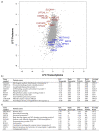Integration and Comparison of Transcriptomic and Proteomic Data for Meningioma
- PMID: 33167358
- PMCID: PMC7694371
- DOI: 10.3390/cancers12113270
Integration and Comparison of Transcriptomic and Proteomic Data for Meningioma
Abstract
Meningioma are the most frequent primary intracranial tumour. Management of aggressive meningioma is complex, and development of effective biomarkers or pharmacological interventions is hampered by an incomplete knowledge of molecular landscape. Here, we present an integrated analysis of two complementary omics studies to investigate alterations in the "transcriptome-proteome" profile of high-grade (III) compared to low-grade (I) meningiomas. We identified 3598 common transcripts/proteins and revealed concordant up- and downregulation in grade III vs. grade I meningiomas. Concordantly upregulated genes included FABP7, a fatty acid binding protein and the monoamine oxidase MAOB, the latter of which we validated at the protein level and established an association with Food and Drug Administration (FDA)-approved drugs. Notably, we derived a plasma signature of 21 discordantly expressed genes showing positive changes in protein but negative in transcript levels of high-grade meningiomas, including the validated genes CST3, LAMP2, PACS1 and HTRA1, suggesting the acquisition of these proteins by tumour from plasma. Aggressive meningiomas were enriched in processes such as oxidative phosphorylation and RNA metabolism, whilst concordantly downregulated genes were related to reduced cellular adhesion. Overall, our study provides the first transcriptome-proteome characterisation of meningioma, identifying several novel and previously described transcripts/proteins with potential grade III biomarker and therapeutic significance.
Keywords: MAOB; biomarker; data integration; drug targets; meningioma; proteomics; transcriptomics.
Conflict of interest statement
The authors declare no conflict of interest. The funders had no role in the design of the study; in the collection, analyses, or interpretation of data; in the writing of the manuscript, or in the decision to publish the results.
Figures





References
-
- Louis D.N., Ohgaki H., Wiestler O.D., Cavenee W.K. WHO Classification of Tumours of the Central Nervous System. 4th ed. Volume 1. International Agency for Research on Cancer; Lyon, France: 2016. p. 408.
-
- Peyre M., Gauchotte G., Giry M., Froehlich S., Pallud J., Graillon T., Bielle F., Cazals-Hatem D., Varlet P., Figarella-Branger D., et al. De novo and secondary anaplastic meningiomas: A study of clinical and histomolecular prognostic factors. Neuro. Oncol. 2018;20:1113–1121. doi: 10.1093/neuonc/nox231. - DOI - PMC - PubMed
Grants and funding
LinkOut - more resources
Full Text Sources
Molecular Biology Databases
Miscellaneous

